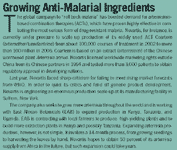Washington Report: Antivirals: Meeting a World of Need
Pharmaceutical Executive
Many still regard FDA's approach as costly and unnecessary. But the prospect of qualifying for purchase by PEPFAR is attracting applicants. The policy has helped bring news AIDS treatments to market.
The whole world wants more antiretroviral medicines (ARVs), particularly fixed-dose combination drugs (FDCs), which are easier for sick people in developing nations to use correctly. US, European, and international organizations are pledging billions of dollars to treat five million AIDS patients over the next few years, and the President's Emergency Plan for AIDS Relief (PEPFAR) plans to spend $15 billion over five years to treat two million individuals—huge leaps from the mere thousands now receiving ARVs in developing nations. US initiatives have drawn considerable attention, along with criticism, about reinventing the wheel and wasting resources on pricey branded medicines.

Jill Wechsler
Ensuring Supply
A crucial first step is to ramp up the availability of treatment services and medical supplies. That will be a challenge, but it also offers pharmaceutical manufacturers a great opportunity to demonstrate their ability to provide affordable, effective treatments. Generic drug makers are already playing an important role in these efforts—a role they are poised to expand if innovator firms shy away. Meanwhile, the industry has to formulate effective combination products, meet worldwide regulatory standards, and obtain ingredients—an assignment that will stress pharma on all sides. Bristol-Myers Squibb, for example, reported in March that it might not meet demand for Zerit (stavudine) and Sustiva (efavirenz).
Supply problems were aggravated this past year when the World Health Organization (WHO) delisted several important generic FDCs from the agency's prequalification program for drugs to treat AIDS, malaria, and tuberculosis. The issue: discrepancies in bioequivalence (BE) data. WHO, which began inspecting BE contract labs in 2004, discovered that the facilities did not meet international standards. What is more, some manufacturer BE data did not match information in applications. It has taken months for the manufacturers to get their drugs back on the WHO list.

Growing Anti-Malarial Ingredients
Meeting Standards
The delisting raised questions about the reliability of WHO's prequalification system, a skepticism shared by US health officials. Even though WHO maintains that the incident demonstrates its ability to maintain high standards, PEPFAR requires drugs purchased with US dollars to be approved by FDA, ostensibly to fend off charges that America foists lower-quality treatments on poor nations.
Critics of the US position believe PEPFAR's real goal is to protect pharma patents. A commitment to purchasing FDA-approved products translates into a commitment to buying more high-cost brand-name drugs—ultimately limiting the number of patients treated. FDA's solution is to grant "tentative approval" to generic drugs that meet regulatory standards (and thus are eligible for purchase by PEPFAR programs) but cannot be marketed in the United States for patent reasons. A May 2004 FDA guidance spells out how manufacturers can develop and gain expedited review of FDCs and co-packaged ARVs.
Although many observers still regard FDA's approach as costly and unnecessary, the prospect of qualifying for purchase by PEPFAR is attracting applicants, and the accelerated-review policy has helped bring new AIDS therapies to market quickly.
In January, Aspen Pharmacare of South Africa received the first tentative approval for a co-packaged drug regimen that includes two tablets each of generic versions of Glaxo's Combivir (lamivudine/zidovudine) and Boehringer's Viramune (nevirapine). A generic version of Combivir from India's Aurobindo Pharma gained tentative approval in July. FDA has also okayed many individual generic AIDS treatments, including lamivudine, zidovudine, nevirapine, efavirenz, and stavudine—and a dozen applications are in the review pipeline.
FDA has been able to approve PEPFAR applications in four to eight weeks. FDA deputy commissioner Murray Lumpkin says that is because the Office of Generic Drugs (OGD) is providing a lot of hand-holding to generics companies, especially those unfamiliar with agency policies. Speedy approvals require quality applications and early inspection of BE data and manufacturing facilities."
Problems with bioequivalence are FDA's main reason for rejecting FDC applications, and formulation issues can be difficult to solve. Last December, for example, Gilead Sciences and BMS announced plans to develop an FDC combining Gilead's Truvada (emtricitabine/tenofovir) and BMS' Sustiva (efavirenz) to create a more potent once-daily AIDS treatment. But several test versions failed to achieve bioequivalence to the drugs used separately. Gilead plans to test three more formulations in hope of submitting an application in 2006.
Although FDA approval makes drugs eligible for PEPFAR, manufacturers still have to register the products in each recipient country before they can be distributed to patients. Ironically, African governments also want FDA-approved drugs included on WHO's prequalification list so that they can use the same drugs for all programs. FDA and WHO officials recently signed an agreement that will permit FDA to provide confidential data to WHO to facilitate prequalification.
Managing the Supply Chain
Drug counterfeiting and diversion of low-cost FDCs from Third World markets are likely to grow as demand for AIDS therapies grows. The United Kingdom's National Health Service reported in April that it had erroneously purchased ARVs illegally diverted from Kenya. The Global Fund to Fight AIDS, Tuberculosis, and Malaria recently halted its AIDS programs in Uganda after audits uncovered discrepancies in program accounts.
To prevent such problems, donors and health programs seek to establish secure distribution and warehousing systems to manage the fast-expanding quantities of ARVs going to developing countries. PEPFAR and the US Agency for International Development (USAID) are currently designing their own secure supply-chain management system (SCMS) for the program's 15 focus countries. USAID is negotiating a contract, which could amount to $7 billion over five years, to establish a "one-stop shopping point" for medical supplies, which also will negotiate prices, prevent theft and diversion, and verify quality.
Many observers consider the PEPFAR/USAID initiative redundant with similar programs already under development. PEPFAR officials say that local governments and third-party donors will have the option of using their own systems instead of SCMS, but organizations receiving PEPFAR funds may well feel pressure to adopt the US program.
Promoting Innovation
While the immediate goal of AIDS programs is to provide treatment for millions of infected patients, a broader aim is to encourage development of new therapies to meet future needs. The good news is that efforts to deal with current crises do not seem to be curbing innovation. In July, Boehringer Ingelheim announced FDA approval of its new protease inhibitor Aptivus (tipranavir). Massachusetts-based Panacos Pharmaceuticals unveiled early clinical trial results in August indicating high efficacy from a new maturation-inhibitor antiretroviral made from the bark of the European plane tree. New studies are examining whether ARVs may be effective at preventing HIV infection in the first place.
Research also is generating hope for new treatments for malaria and TB. Last year, the Institute of Medicine issued a report calling for major global investment in new artemisinin-based combination therapies (ACTs) due to the drug's positive results. Promising treatments against tuberculosis are being tested, which is important in the United States as drug-resistant TB cases have emerged in California. The resulting new drugs may prevent disease spread and help cure already stricken patients.
Jill Wechsler is Pharm Exec's Washington correspondent. She can be reached at jwechsler@advanstar.com

Pfizer, GSK Gain ACIP Recommendations for RSV and Meningococcal Vaccines
April 18th 2025The Centers for Disease Control and Prevention’s Advisory Committee on Immunization Practices voted to expand access to Pfizer’s respiratory syncytial virus vaccine Abrysvo for high-risk adults in their 50s and voted in favor of GSK’s meningococcal vaccine, Penmenvy, for streamlined adolescent protection.
Navigating Distrust: Pharma in the Age of Social Media
February 18th 2025Ian Baer, Founder and CEO of Sooth, discusses how the growing distrust in social media will impact industry marketing strategies and the relationships between pharmaceutical companies and the patients they aim to serve. He also explains dark social, how to combat misinformation, closing the trust gap, and more.
Pfizer, GSK Gain ACIP Recommendations for RSV and Meningococcal Vaccines
April 18th 2025The Centers for Disease Control and Prevention’s Advisory Committee on Immunization Practices voted to expand access to Pfizer’s respiratory syncytial virus vaccine Abrysvo for high-risk adults in their 50s and voted in favor of GSK’s meningococcal vaccine, Penmenvy, for streamlined adolescent protection.
Navigating Distrust: Pharma in the Age of Social Media
February 18th 2025Ian Baer, Founder and CEO of Sooth, discusses how the growing distrust in social media will impact industry marketing strategies and the relationships between pharmaceutical companies and the patients they aim to serve. He also explains dark social, how to combat misinformation, closing the trust gap, and more.
2 Commerce Drive
Cranbury, NJ 08512
All rights reserved.